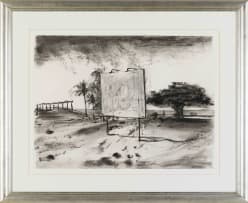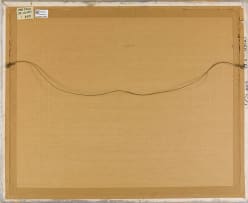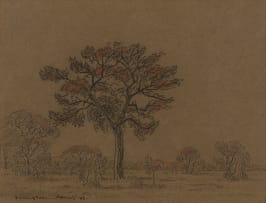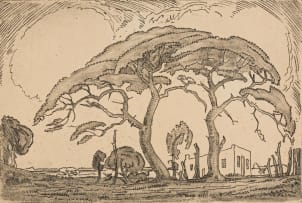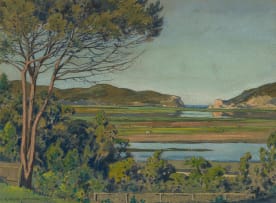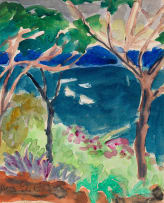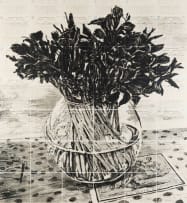Pretoria Sale: Modern and Contemporary Art
Live Virtual Auction, 21 July 2024
Session 1
About this Item
signed and numbered 68
Provenance
Acquired from the artist, and thence by descent to the current owner.
Notes
This undated charcoal drawing distils motifs and ideas central to William Kentridge's celebrated drawing practice. The composition centrally depicts a hoarding in a sparse landscape with dissimilar trees and an empty bench. These elements are staged as much as observed beneath a leaden sky featuring tendrils of moisture that offer no replenishment to the parched landscape. The blank hoarding, far from saying nothing, offers a rich invitation to consider Kentridge's drawing processes as well as speculate on the pronounced influence of cinema on his overall practice.
Kentridge's landscape drawings frequently include blank cinema screens, billboards and other infrastructures of communication. The early drawing Flood at the Opera House (1986) provides an important clue as to their visual origin. Kentridge's drawings from the 1980s were, in the main, darkly toned and depicted people, animals and things crowded together in theatres, cafes and suburban redoubts. The surrealistic bourgeois decadence they recorded was a correlative of social decay. Trees were introduced later, in 1998, when he made the animated film Stereoscope and adapted Monteverdi's 1640 opera Il Ritorno d'Ulisse for the stage in New York.
The late 1990s was a period of spectacular international ascendance for Kentridge. By this time his drawing practice had undergone noticeable shifts, both in style and content. In 1989, Kentridge presented the Johannesburg, 2nd Greatest City after Paris, the first animated film in his on-going Drawings for Projection series. The demands of his artisanal filmmaking process, which eschews computers, favouring instead evolving a scene for the camera on a single piece of paper through erasure and redrawing, inevitably changed his drawing style.
Among other changes, his scenography became less claustrophobic and collagistic, and also more recognisably of Johannesburg. Of his decision to venture beyond the safe bourgeois redoubts of his early Weimar-inspired drawings, Kentridge has stated: 'I started calling myself an artist in my thirties when I discovered not just the necessity but the pleasure of drawing the landscape just to the south of Johannesburg, to the south of the leafy suburb I lived in. And also when I discovered the pleasure of a soft chamois leather dipped into charcoal dust and wiped across the white surface of the paper, leaving not just a train of dark charcoal grit on the paper but also of a darkening sky above a light horizon.'1
There is striking continuity between Kentridge's rich understanding of his drawing process and the things he portrays. 'Charcoal and paper are not perfect substances,' writes Kentridge in Six Drawing Lessons. 'Charcoal can be erased easily, but not perfectly. The paper is tough and can be erased, redrawn, erased, and still hold its structure - but not without showing its damage. The erasure is never perfect.'2 The same broadly holds of the humaninterfered landscape in this composition. 'It is a landscape that is explicitly social. It is also temporal - everything in the landscape has the signs of having been put there and having been made - all features have the potential to be unmade.'3
Kentridge's billboard unavoidably operates like a blank screen for projection, a familiar motif from art history that encompasses artists as diverse as Jeremy Wafer and Hiroshi Sugimoto. The blank screen is a bountiful subject, inviting deliberations on leisure, spectacle, industrial fabrication, technology, light and time. But what does it propose in relation to Kentridge's drawing? One possible answer involves the artist's abundant love for film.
Kentridge has directly quoted filmmakers Dziga Vertov, George Méliès and Federico Fellini in his work. A suite of drawings from 1985 variously depicts Ingrid Bergman, Humphrey Bogart, Marlene Dietrich, James Dean and Groucho Marx. In 1998, when Kentridge exhibited at the Drawing Center in New York, curator and art historian Michael Rush wrote a penetrating review linking Kentridge to the avant-garde tradition of French filmmaker Jean-Luc Godard. The history of film, like its companion history of art, is a replenishing source for Kentridge.
1. William Kentridge & Jane Taylor (2018) That Which We Do Not Remember, Sydney: Naomi Milgrom Foundation. Page 102.
2. William Kentridge (2014) Six Drawing Lessons, Cambridge: Harvard University Press. Page 95.
3. William Kentridge (1998), 'Felix in Exile: Geography of Memory', in William Kentridge, Carolyn Christov-Bakargiev (ed.), Brussels: Société des Expositions du Palais des Beaux-Arts de Bruxelles. Pages 95-96.


